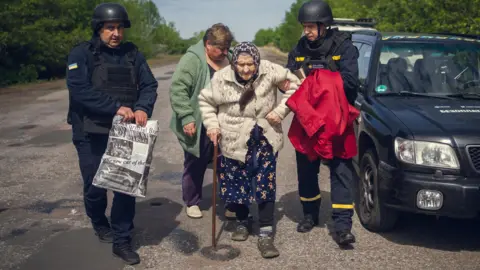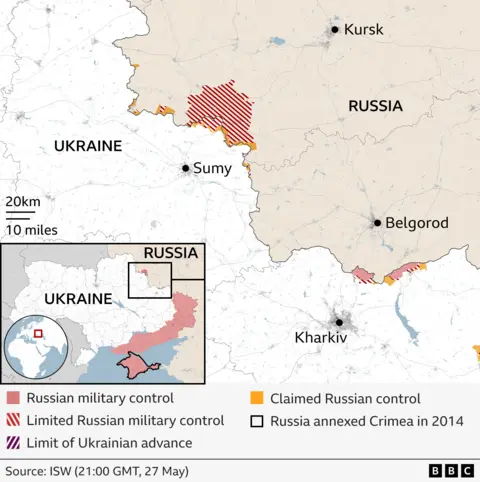Russian advance in Ukraine's north east may be attempt to create 'buffer zone'
 Emergency services of Sumy
Emergency services of SumyRussian forces are making gains in the Ukrainian north-eastern region of Sumy - a development that may be linked to Moscow's attempts to create "buffer zones" along the border, Ukrainian regional authorities have said.
The head of the Sumy region Oleh Hryhorov said Russian forces have seized four villages and that fighting is continuing near other settlements in the area "with the aim of setting up a so-called 'buffer zone'".
Russia maintains it has captured six villages in Sumy so far.
Last week, Russian President Vladimir Putin announced a plan to create "security buffer zones" along the border. "Enemy firing points are being actively suppressed, the work is under way," he said.
The buffer zones would be created to provide "additional support" to areas in Russia which border Ukraine's Kharkiv, Sumy and Chernihiv regions, Putin said.
In a statement on Facebook on Monday, Sumy's Hryhorov wrote: "The enemy is continuing attempts to advance with the aim of setting up a so-called 'buffer zone',"
He added that the villages of Novenke, Basivka, Veselivka and Zhuravka - all in Sumy - had been occupied.
Kyiv has not yet officially stated that Russian troops are in the Sumy region and, when contacted by the BBC, Hryhorov declined to confirm the information he shared on Monday, saying only the military could comment on front-line activities.

The General Staff's daily briefings only mentioned clashes and other military activities in "the Kursk direction" - meaning towards the border with Russia - without naming any specific locations.
The Ukrainian army's group of forces that coordinate military activities in the region declined the BBC's request for comment, indicating that information about the Russian advancement in the north is an extremely sensitive issue for Ukrainian authorities.
However, in his address on Monday night Ukraine's President Volodymyr Zelensky mentioned Russia's "preparation for new offensives" – which was largely interpreted as a reference to the events in the Sumy region.
Deep State map, a group that monitors the latest front-line developments in Ukraine, marked four Ukrainian villages as fully controlled by Russian forces even before Hyrhorov's announcement.
Deep State's co-founder Roman Pohorily said that Russian troops have been pushing in those areas since March.
Ukrainian military observer Kostyantyn Mashovets confirmed this, although he pointed out that Russia's advance has been very slow - about 1km (0.6 miles) in the past two weeks. Mr Mashovets also said Moscow recently relocated new units from the Donbas - to Sumy region.
Colonel Vadym Mysnyk, a spokesperson for a formation of the ground forces that is involved in defending the Sumy region, said Russian forces mostly use small groups on motorbikes and buggies during their attacks.
The movement of larger armoured vehicles could be quickly spotted by drones and destroyed, Col Mysnyk explained. On the battlefield, speed and mobility are crucial.
But the Sumy region has regularly come under attack by Russian air strikes and artillery fire, with the regional administration reporting that since Saturday, Russia has dropped more than 30 guided bombs on the area.
One of the biggest attacks took place last month when ballistic missiles hit the city of Sumy killing 34 people. Several weeks later, drones hit an intercity bus killing nine people.
Russia targets residential buildings, hospitals and civilian vehicles to spread panic among the population, Col Mysnyk claimed. Russia denies that it targets civilians in strikes, saying they are aimed at military targets.
Local authorities say evacuation is taking place in 202 settlements close to the front line, which makes up a third of all territorial communities of the region.
Serhiy Grabskiy, a retired colonel and a military expert, agreed that the advances in Sumy are part of Moscow's plan to create a buffer zone.
Grabskiy said Russia's main strategic goal is to seize the Donbas region in the east, where the most intensive fighting is taking place.
Considering the number of troops they have, Russia "cannot concentrate major forces to go deep in the north", Grabskiy argued.
He called the Sumy region a "zone of distraction" - as by maintaining pressure in the north, Russia forces Ukraine to spread its resources and weaken positions in key front-line areas.
The US-based Institute for the Study of War think tank also reports that any success in Sumy could be used by Putin as a leverage and justification for new territorial demands as part of future peace negotiations.
However, observers agree there is no immediate threat of a major breakthrough in the Sumy region.
Based on the speed of their gains in the region so far, it is unlikely that in the near future Russian forces could capture a major city like Sumy, which had a population of 250,000 before the invasion.
Mr Pohorily of Deep State said Ukrainian troops have managed to stabilise the front line. "It's been almost three months since [Russia] started their operation in the Sumy region and yet, they are still at the border areas," he said.
Col Mysnyk claimed that Ukraine has built defence lines along the entire border since 2022 and at present they're much better prepared to stop the Russian forces than they were at the start of the Russian invasion.
But those measures may not last long if the Kremlin's priorities change and Moscow sends greater forces to Sumy.
